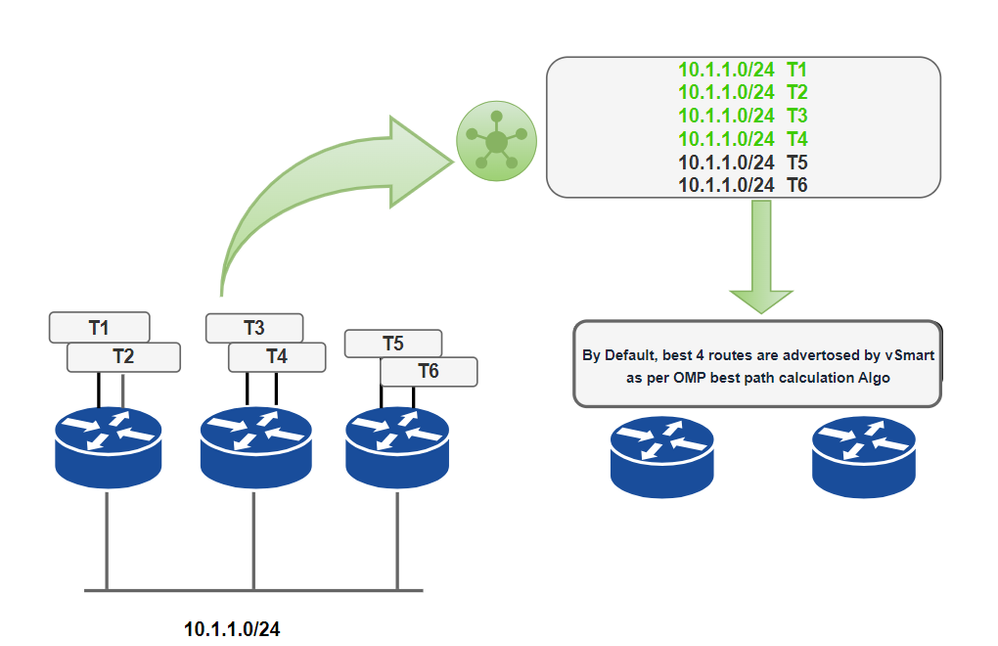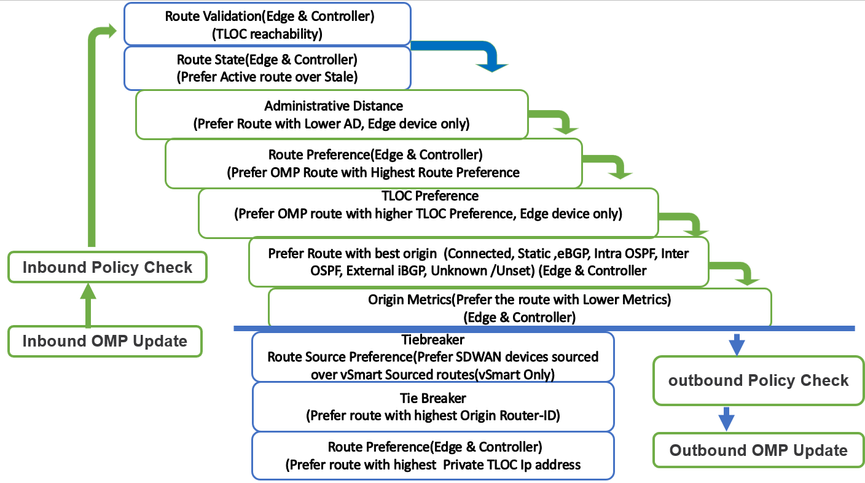Introduction
This document describes troubleshooting performance issues and designing the application flow using the Overlay Management Protocol (OMP) best-path calculation algorithm.
Prerequisites
Cisco Software Defined Wide Area Network (SD-WAN) solution knowledge is recommended.
Components Used
The information in this document was created from the devices in a specific lab environment. All of the devices used in this document started with a cleared (default) configuration. If your network is live, ensure that you understand the potential impact of any command.
This document is based on these software and hardware versions:
- Cisco IOS® Catalyst SD-WAN Manager aka vManage
- Cisco IOS Catalyst SD-WAN Validator aka vBond
- Cisco IOS Catalyst SD-WAN Controllers aka vSmart
- Cisco IOS XE Catalyst SD-WAN device
OMP Best-Path Calculation
In the Cisco SD-WAN solution, Cisco IOS XE Catalyst SD-WAN devices advertise their local subnets to the Cisco Catalyst SD-WAN Controller via Overlay Management Protocol (OMP). In a typical production environment, local networks are attached to two or more WAN Edge devices for redundancy and additionally, each subnet advertised is reachable via each Transport Locator (TLOC).
 Default OMP Route Advertisement
Default OMP Route Advertisement
As per the topology, three Cisco IOS XE Catalyst SD-WAN devices are connected to subnet 10.1.1.0/24, and T1- T6 are the TLOCs. The first router advertises the subnet 10.1.1.0/24 to the Cisco Catalyst SD-WAN Controller which is reachable via TLOC T1 and TLOC T2. Similarly, the other two SD-WAN routers advertise the same subnet 10.1.1.0/24 which is reachable via their respective TLOCs 3,4,5, and 6 and the Cisco Catalyst SD-WAN Controller has six OMP routes for the 10.1.1.0/24 prefix. Now vSmart is going to run the OMP Best-Path Calculation Algorithm on all available routes for this prefix to select the path to be sent out to all WAN edge routers. Note that By default, Cisco IOS XE Catalyst SD-WAN devices and Cisco Catalyst SD-WAN Controllers advertise up to four equal-cost route–TLOC tuples for the same route. You can configure it to advertise from 1 to 16 route–TLOC tuples for the same route:
Device(config-omp)# send-path-limit <1 -16>
You can also configure the Cisco Catalyst SD-WAN Controller to advertise the backup routes to Cisco IOS XE Catalyst SD-WAN devices. By default, OMP advertises only the best route or routes. If you configure to send backup paths, OMP also advertises the first non-best route in addition to the best route or routes.
Device(config-omp)# send-backup-paths
Also, SD-WAN devices install OMP paths received from the Cisco Catalyst SD-WAN Controller into their local route table. By default, SD-WAN devices install a maximum of four unique OMP paths into their route table. You can modify this number via this command:
Device(config-omp)# ecmp-limit <1 -16 >
The maximum number of OMP paths installed can range from 1 through 16 depending upon the limit configured.
OMP Route Advertisement
On Cisco SD-WAN Controllers and Cisco IOS XE Catalyst SD-WAN devices, OMP advertises the routes and services that it has learned from its local site to its peers, along with their corresponding transport location mappings, which are called TLOCs. These routes are called OMP routes or vRoutes. These routes are a tuple consisting of the route and TLOC associated with the route. It is through the OMP Cisco Catalyst SD-WAN Controller that the topology and the services available in the network are learned. OMP performs path selection, loop avoidance, and policy implementation on each local device to decide which routes are installed in the local routing table of any Cisco IOS XE Catalyst SD-WAN device.
OMP advertises these types of routes:
- OMP Routes/vRoutes — Prefixes that establish reachability between end-points that use the OMP-orchestrated transport network. OMP routes represent different services in the Central Data Center, branch, hosts & other end-points in any location of the overlay network.
- TLOCs — Identifiers that tie an OMP route to a physical location. The TLOC is the only entity of the OMP routing domain visible to the underlying network, and it must be reachable via routing in the underlying network table. Compared to Border Gateway Protocol (BGP), the TLOC acts as the next hop for OMP routes.
- Service Routes — Routes that tie an OMP route to a service in the network, specifying the location of the service in the network. Services include firewalls, Intrusion Detection Systems (IDPs), and load balancers.
OMP Routes Attributes
Cisco SD-WAN devices advertise the site-local routes with these attributes:
- TLOC
- System IP
- Color
- Encapsulation Type on Tunnel
- Origin - Source of the route, such as Connected, Static, EIGRP, BGP, OSPF, connected, and static, and the metric associated with the original route
- Originator - OMP identifier of the originator of the route is the IP address from which the route was learned
- Preference - A higher preference value is preferred
- Service - Network service associated with the OMP route
- Site ID
- Tag - Optional, transitive path attribute
- VPN - VPN or network segment to which the OMP route belongs
TLOC Routes Attributes
TLOC routes identify transport locations. These are the locations in the overlay network that connect to physical transport, such as the point at which a WAN interface connects to a carrier. TLOC routes advertise these attributes:
- TLOC private address - Private IP address of the interface associated with the TLOC
- TLOC public address - NAT-translated address of the TLOC
- Carrier - An identifier of the carrier type, which is generally used to indicate whether the transport is public or private
- Color
- Encapsulation type - Tunnel encapsulation type
- Preference - Degree of preference that is used to differentiate between TLOCs that advertise the same OMP route
- Site ID - Identifier of the site within the Cisco SD-WAN overlay network domain to which the TLOC belongs
- Tag
- Weight - Value that is used to discriminate among multiple entry points if an OMP route is reachable through two or more TLOCs
OMP Best-Path Algorithm and Loop Avoidance

The OMP Best-Path Calculation process is detailed here:
- Prefer the ACTIVE route - An ACTIVE route is preferred over STALE routes. A route is ACTIVE when an OMP session is in UP state with the peer that sent out the route. A route is STALE when the OMP session with the peer who sent out the route is in GRACEFUL RESTART mode.
- Select Valid Routes - For an OMP route to be valid, the route must have a next-hop TLOC that is known and reachable.
- Prefer routes with lower administrative distance (AD) - If the route is valid and received from the same Cisco SD-WAN Device, select the OMP route with lower AD. AD is only compared when the same WAN edge router receives the same site-local prefix from multiple routing protocols. AD is a locally significant value on each router. It is not advertised and does not influence the Cisco SD-WAN Controller, that is vSmart.
- Prefer routes with a high OMP route preference value - By default, all OMP routes have 0 preference and are often used to do traffic engineering.
- Prefer routes with a higher TLOC preference value - Changing the TLOC preference affects vEdges path selection for all VPNs.
- Compare the origin type and Subtype and select the first match in this order:
- Connected
- Static
- EIGRP Summary
- BGP External
- EIGRP Internal
- OSPF/OSPFv3 Intra-area
- OSPF/OSPFv3 Inter-area
- IS-IS Level 1
- EIGRP External
- OSPF/OSPFv3 External (External OSPF Type1 is preferred over External OSPF Type2)
- IS-IS Level 2
- BGP Internal
- Unknown
7. Compare the origin metric- If the origin type of the routes is the same, select the OMP path that has a lower origin metric.
8. Path Source- Prefer a path sourced from an edge router over the same path coming from a Cisco Catalyst SD-WAN Controller.
9. Origin ID - If the origin types are equal, select the routes that have the lowest router ID (System-IP).
10. Private IP Address- If the router IDs are equal, a Cisco vEdge device selects the OMP route with the lower private IP address. If a Cisco vSmart Controller receives the same prefix from two different sites and if all attributes are equal, it chooses both of them.



 Feedback
Feedback